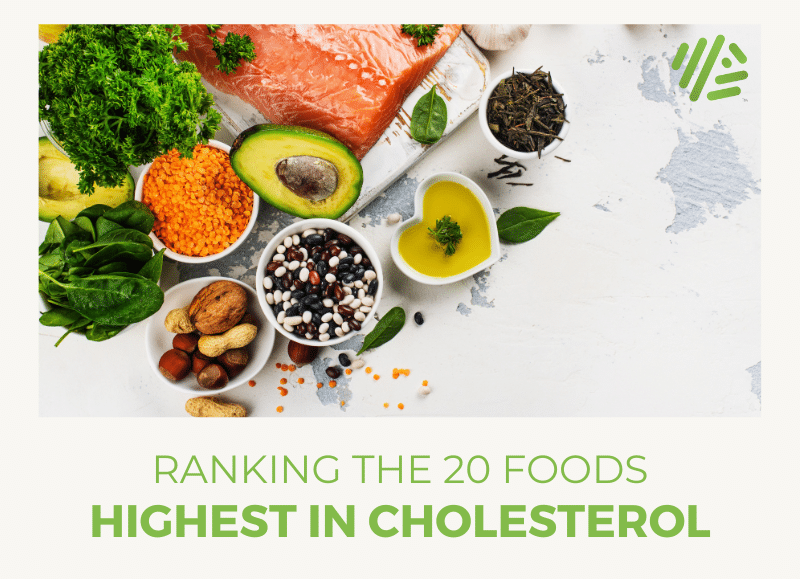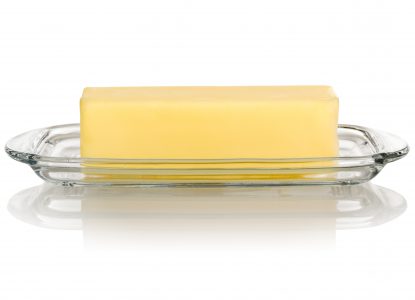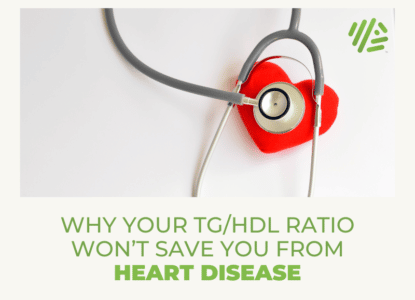Ranking the 20 Foods Highest in Cholesterol
Genes Mentioned

Cholesterol is so fundamental to life that our body’s make 80% of the cholesterol in our system at any given time. In fact, all our cells can make their own cholesterol. Pretty fascinating, right? For most of us, when we absorb cholesterol from food (or the cholesterol re-circulating in bile acids) we tend to make less of it. Conversely, when we absorb less, we make more. In this way, the body keeps cholesterol levels tightly regulated. 1
However, not everyone fits this mold. Some, known as “hyper absorbers,” absorb more cholesterol than most people. 1 These are the folks who should be most vigilant about the dietary cholesterol they consume. Many animal foods are a rich source of cholesterol. So, if you’re trying to reduce your cholesterol intake it’s important to know what to avoid. Typically, most cholesterol is found in the fattier parts of animals. These include the brain, liver, and skin. Eggs and some dairy products are also high in cholesterol. Indeed, cholesterol is only found in foods of animal origin.
Highest cholesterol foods list
According to the National Agricultural Laboratory’s Nutrient Lists from Standard Reference Legacy (2018), the following 20 foods contain the highest amount of cholesterol. Processed, multi-ingredient foods from the list have been deliberately excluded, while single ingredient foodstuffs have the attention. Consider, however, that many of the foods on this list are the main ingredient in other food products, such as eggnog and queso, which typically contain 139-150 mg of cholesterol per cup respectively.
| Description | Measure | Cholesterol (mg) Per Measure | |
| 1 | Pork, fresh, variety meats and by-products, brain, cooked, braised | 3.0 oz | 2169 |
| 2 | Chicken, gizzard, all classes, cooked, simmered | 1.0 cups chopped or dice | 536 |
| 3 | Egg, yolk, raw, frozen, sugared, pasteurized | 1.0 oz | 260 |
| 4 | Egg, whole, raw, fresh | 1.0 large | 186 |
| 5 | Egg, whole, cooked, poached | 1.0 large | 185 |
| 6 | Egg, whole, cooked, fried | 1.0 large | 184 |
| 7 | Fish, roe, mixed species, cooked, dry heat | 1.0 oz | 136 |
| 8 | Cream, fluid, heavy whipping | 1.0 cups, whipped | 136 |
| 9 | Chicken, broilers or fryers, dark meat, meat only, cooked, fried | 1.0 cups | 134 |
| 10 | Cheese, feta | 1.0 cups, crumbled | 134 |
| 11 | Cream, fluid, light whipping | 1.0 cups, whipped | 133 |
| 12 | Cheese, cheddar (Includes foods for USDA’s Food Distribution Program) | 1.0 cups, diced | 131 |
| 13 | Turkey, all classes, back, meat and skin, cooked, roasted | 1.0 cups, chopped or diced | 127 |
| 14 | Pork, fresh, leg (ham), whole, separable lean only, cooked, roasted | 1.0 cups, diced | 127 |
| 15 | Cheese, muenster | 1.0 cups, diced | 127 |
| 16 | Cheese, swiss | 1.0 cups, diced | 123 |
| 17 | Pork, fresh, shoulder, whole, separable lean and fat, cooked, roasted | 1.0 cups, diced | 122 |
| 18 | Cheese, pasteurized process, swiss | 1.0 cups, diced | 119 |
| 19 | Chicken, skin (drumsticks and thighs), raw | 4.0 oz | 119 |
| 20 | Chicken, broilers or fryers, drumstick, meat and skin, cooked, stewed | 1.0 cups, chopped or diced | 116 |
Source: NAL, Nutrient Lists from Standard Reference Legacy (2018), Cholesterol. Accessed 14th January, 2020. 1
Most common high cholesterol foods
While the list above features foods found to have the highest levels of cholesterol, these aren’t necessarily the key ones to watch out for. According to the National Health and Nutrition Examination Survey (NHANES), the top sixteen food sources of cholesterol eaten in America in 2005-2006 were:
- Eggs, and mixed egg dishes
- Chicken
- Beef, and beef mixed dishes
- Burgers
- Regular cheese
- Sausage, franks, bacon, and ribs
- Other fish and fish mixed dishes
- Grain-based dessert
- Dairy desserts
- Pasta and pasta dishes
- Pizza
- Mexican mixed dishes
- Cold cuts
- Reduced fat milk
- Pork and pork mixed dishes
- Shrimp and shrimp mixed dishes.
In general, the most common food sources of cholesterol included egg yolk, shrimp, beef, and pork, poultry, as well as cheese and butter. Butter contains 50 g of saturated fat and 214 mg of cholesterol per 100 g, while a 50g egg contains just 1.56 g of saturated fat and 186 mg of cholesterol. 2 If you’re looking to keep your cholesterol intake in check, consider removing the foods listed above (and those similar) from your diet. Notice that, with the notable exception of eggs, many of the foods high in cholesterol are also high in saturated fat, which instructs your liver to produce more cholesterol. Something of a double whammy for cholesterol? Maybe.
The takeaway on cholesterol rich foods
In conclusion, high-cholesterol foods may not meaningfully alter blood lipids in many people. Still, it may be beneficial for many of us to limit foods high in cholesterol that are also high in saturated fat. Eating saturated fat causes some of us to make lots and lots more cholesterol, which not only increases total cholesterol, but also LDL-C. Some of the best ways to reduce overall cholesterol production include avoiding trans fats, keeping saturated fat intake in check, and getting regular aerobic exercise. If you are someone who is prone to high cholesterol, it could be that you are one of the unlucky ones who tend to absorb more of the cholesterol from food. However, another culprit could be dietary fat, not cholesterol. Just as some people keep absorbing cholesterol even as they also make more of it, others tend to make a lot more cholesterol when they eat a diet high in saturated fats.



